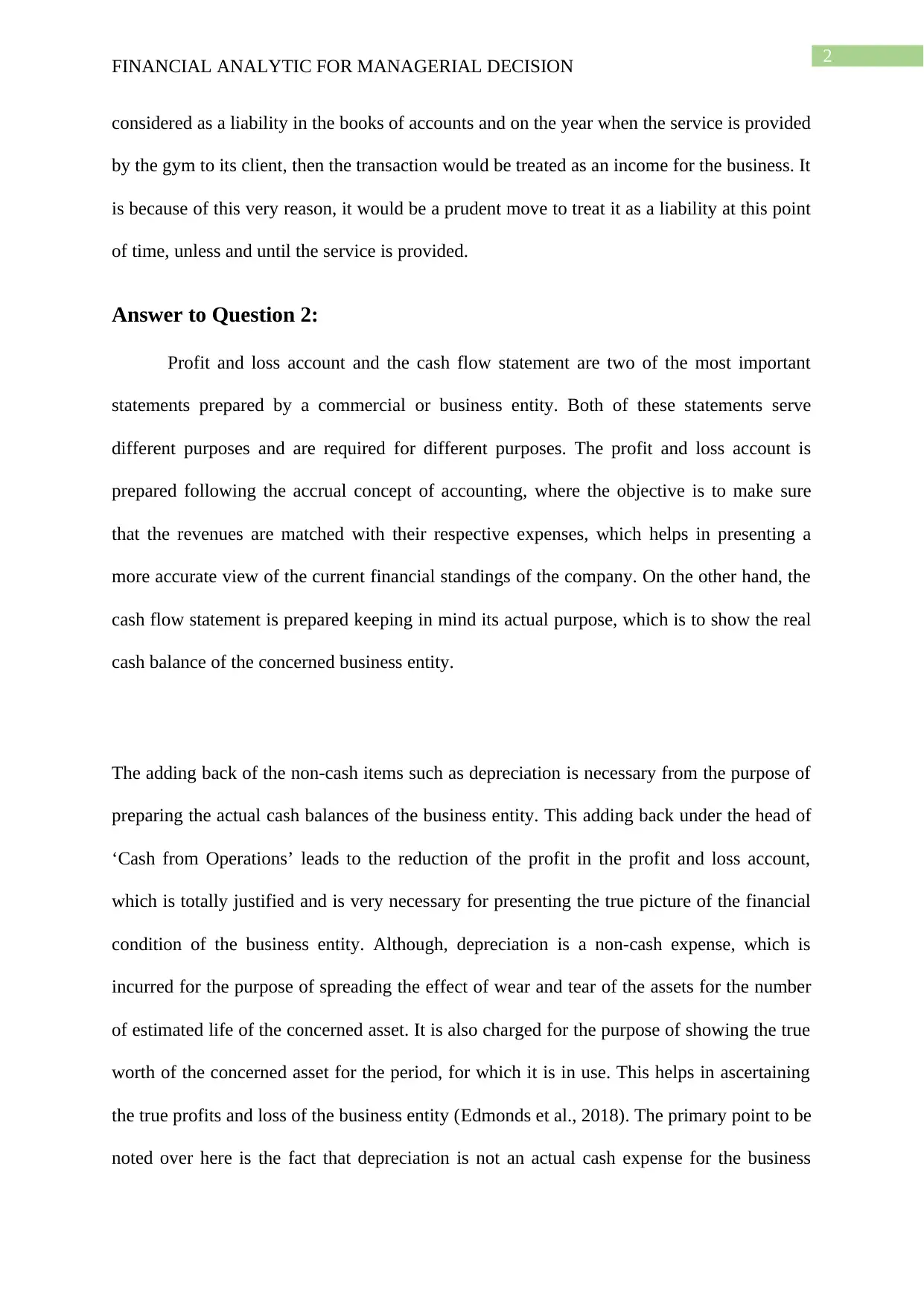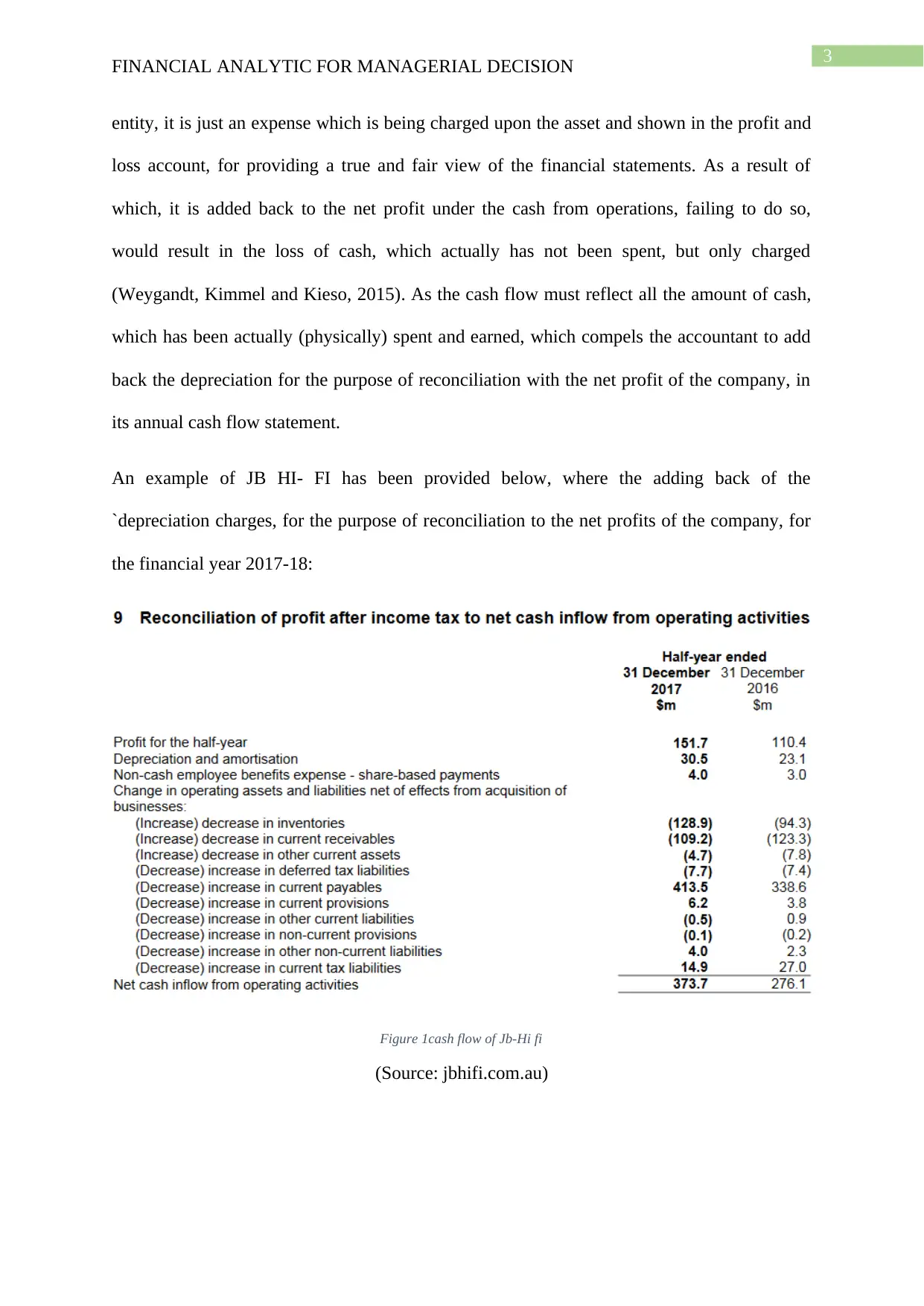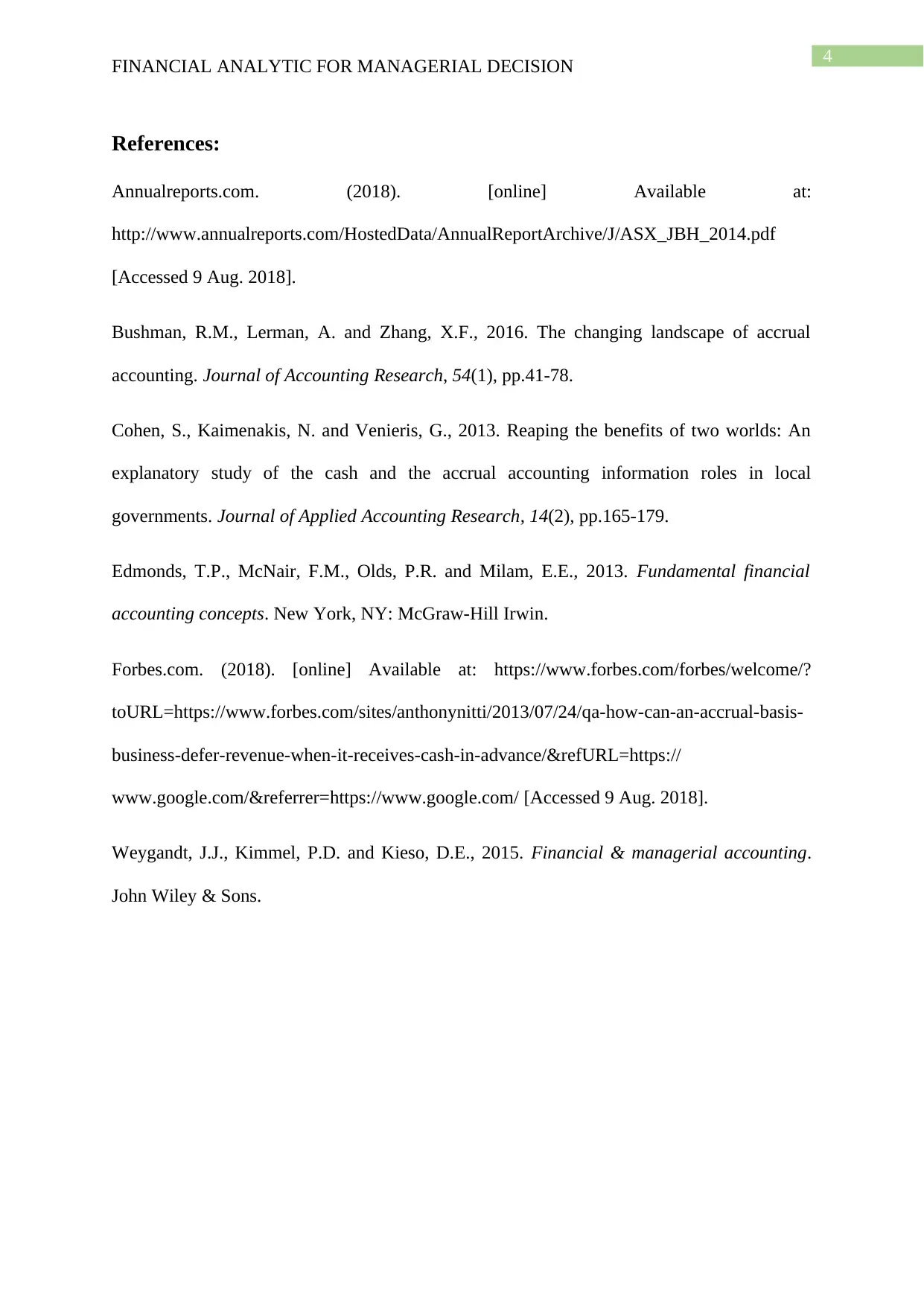BUSM 4154: Financial Analytics and Managerial Decision Report
VerifiedAdded on 2023/06/09
|5
|1197
|325
Report
AI Summary
This report provides a financial analysis related to managerial decision-making, focusing on the application of accounting standards and the interpretation of financial statements. It addresses the treatment of membership fees as liabilities and explains the importance of accrual accounting. The report also clarifies the relationship between the profit and loss account and the cash flow statement, emphasizing the role of depreciation in presenting an accurate financial picture. Examples and references are included to support the analysis and provide further context.

Running Head: FINANCIAL ANALYTIC FOR MANAGERIAL DECISION
Name of the Student
Name of the University
Author note
Name of the Student
Name of the University
Author note
Paraphrase This Document
Need a fresh take? Get an instant paraphrase of this document with our AI Paraphraser

1
FINANCIAL ANALYTIC FOR MANAGERIAL DECISION
Answer to Question 1:
Adherence to the accounting standards and principles is the framework upon which
the treatment of the finances of any commercial business entity or any other entity engaging
in any form of commercial activities, is regularly done. These accounting principles and
standards, help in ensuring the authenticity to the treatment of the different transactions,
which have been undertaken by the business entity. Similarly, in the case of a gym,
membership becomes a very integral part of its financial transactions, as it provides services
in exchange for these fees, thus forming a significant part of their entire revenue system. In
the case of the gym, membership fees must be treated with the adequate amount of financial
prudence, which is expected in these kinds of matters.
In the case of the membership fees which has been received in advance, it would be treated as
a liability until and unless the service is being provided to the client. Under the accrual
concept of accounting, revenues and expenses are recognised only when the former is
realised and the latter one is paid (Bushman, Lerman and Zhang, 2016). Although many
small businesses, opt for cash basis of accounting, for maintaining simplicity, but it is the
authenticity and the accuracy, which is provided by the accrual basis of accounting, which
makes it one of the most followed form of accounting concept. Cash basis of accounting,
might be simple in its format and treatment, but it fails to provide the correct state of affairs
of the business (Cohen, Kaimenakis and Venieris, 2013). It is not useful for those types of
cases, where transactions on credit takes place on a comparatively regular basis.
When the client pays his or her membership fees twelve months upfront, then in such cases, it
is recommended to treat it as a liability in the financial statements, as the services for those
twelve months has not been provided by the gym to its client, it is due, it has not been
provided (Forbes.com, 2018). For the current time period, the transaction would be
FINANCIAL ANALYTIC FOR MANAGERIAL DECISION
Answer to Question 1:
Adherence to the accounting standards and principles is the framework upon which
the treatment of the finances of any commercial business entity or any other entity engaging
in any form of commercial activities, is regularly done. These accounting principles and
standards, help in ensuring the authenticity to the treatment of the different transactions,
which have been undertaken by the business entity. Similarly, in the case of a gym,
membership becomes a very integral part of its financial transactions, as it provides services
in exchange for these fees, thus forming a significant part of their entire revenue system. In
the case of the gym, membership fees must be treated with the adequate amount of financial
prudence, which is expected in these kinds of matters.
In the case of the membership fees which has been received in advance, it would be treated as
a liability until and unless the service is being provided to the client. Under the accrual
concept of accounting, revenues and expenses are recognised only when the former is
realised and the latter one is paid (Bushman, Lerman and Zhang, 2016). Although many
small businesses, opt for cash basis of accounting, for maintaining simplicity, but it is the
authenticity and the accuracy, which is provided by the accrual basis of accounting, which
makes it one of the most followed form of accounting concept. Cash basis of accounting,
might be simple in its format and treatment, but it fails to provide the correct state of affairs
of the business (Cohen, Kaimenakis and Venieris, 2013). It is not useful for those types of
cases, where transactions on credit takes place on a comparatively regular basis.
When the client pays his or her membership fees twelve months upfront, then in such cases, it
is recommended to treat it as a liability in the financial statements, as the services for those
twelve months has not been provided by the gym to its client, it is due, it has not been
provided (Forbes.com, 2018). For the current time period, the transaction would be

2
FINANCIAL ANALYTIC FOR MANAGERIAL DECISION
considered as a liability in the books of accounts and on the year when the service is provided
by the gym to its client, then the transaction would be treated as an income for the business. It
is because of this very reason, it would be a prudent move to treat it as a liability at this point
of time, unless and until the service is provided.
Answer to Question 2:
Profit and loss account and the cash flow statement are two of the most important
statements prepared by a commercial or business entity. Both of these statements serve
different purposes and are required for different purposes. The profit and loss account is
prepared following the accrual concept of accounting, where the objective is to make sure
that the revenues are matched with their respective expenses, which helps in presenting a
more accurate view of the current financial standings of the company. On the other hand, the
cash flow statement is prepared keeping in mind its actual purpose, which is to show the real
cash balance of the concerned business entity.
The adding back of the non-cash items such as depreciation is necessary from the purpose of
preparing the actual cash balances of the business entity. This adding back under the head of
‘Cash from Operations’ leads to the reduction of the profit in the profit and loss account,
which is totally justified and is very necessary for presenting the true picture of the financial
condition of the business entity. Although, depreciation is a non-cash expense, which is
incurred for the purpose of spreading the effect of wear and tear of the assets for the number
of estimated life of the concerned asset. It is also charged for the purpose of showing the true
worth of the concerned asset for the period, for which it is in use. This helps in ascertaining
the true profits and loss of the business entity (Edmonds et al., 2018). The primary point to be
noted over here is the fact that depreciation is not an actual cash expense for the business
FINANCIAL ANALYTIC FOR MANAGERIAL DECISION
considered as a liability in the books of accounts and on the year when the service is provided
by the gym to its client, then the transaction would be treated as an income for the business. It
is because of this very reason, it would be a prudent move to treat it as a liability at this point
of time, unless and until the service is provided.
Answer to Question 2:
Profit and loss account and the cash flow statement are two of the most important
statements prepared by a commercial or business entity. Both of these statements serve
different purposes and are required for different purposes. The profit and loss account is
prepared following the accrual concept of accounting, where the objective is to make sure
that the revenues are matched with their respective expenses, which helps in presenting a
more accurate view of the current financial standings of the company. On the other hand, the
cash flow statement is prepared keeping in mind its actual purpose, which is to show the real
cash balance of the concerned business entity.
The adding back of the non-cash items such as depreciation is necessary from the purpose of
preparing the actual cash balances of the business entity. This adding back under the head of
‘Cash from Operations’ leads to the reduction of the profit in the profit and loss account,
which is totally justified and is very necessary for presenting the true picture of the financial
condition of the business entity. Although, depreciation is a non-cash expense, which is
incurred for the purpose of spreading the effect of wear and tear of the assets for the number
of estimated life of the concerned asset. It is also charged for the purpose of showing the true
worth of the concerned asset for the period, for which it is in use. This helps in ascertaining
the true profits and loss of the business entity (Edmonds et al., 2018). The primary point to be
noted over here is the fact that depreciation is not an actual cash expense for the business
⊘ This is a preview!⊘
Do you want full access?
Subscribe today to unlock all pages.

Trusted by 1+ million students worldwide

3
FINANCIAL ANALYTIC FOR MANAGERIAL DECISION
entity, it is just an expense which is being charged upon the asset and shown in the profit and
loss account, for providing a true and fair view of the financial statements. As a result of
which, it is added back to the net profit under the cash from operations, failing to do so,
would result in the loss of cash, which actually has not been spent, but only charged
(Weygandt, Kimmel and Kieso, 2015). As the cash flow must reflect all the amount of cash,
which has been actually (physically) spent and earned, which compels the accountant to add
back the depreciation for the purpose of reconciliation with the net profit of the company, in
its annual cash flow statement.
An example of JB HI- FI has been provided below, where the adding back of the
`depreciation charges, for the purpose of reconciliation to the net profits of the company, for
the financial year 2017-18:
Figure 1cash flow of Jb-Hi fi
(Source: jbhifi.com.au)
FINANCIAL ANALYTIC FOR MANAGERIAL DECISION
entity, it is just an expense which is being charged upon the asset and shown in the profit and
loss account, for providing a true and fair view of the financial statements. As a result of
which, it is added back to the net profit under the cash from operations, failing to do so,
would result in the loss of cash, which actually has not been spent, but only charged
(Weygandt, Kimmel and Kieso, 2015). As the cash flow must reflect all the amount of cash,
which has been actually (physically) spent and earned, which compels the accountant to add
back the depreciation for the purpose of reconciliation with the net profit of the company, in
its annual cash flow statement.
An example of JB HI- FI has been provided below, where the adding back of the
`depreciation charges, for the purpose of reconciliation to the net profits of the company, for
the financial year 2017-18:
Figure 1cash flow of Jb-Hi fi
(Source: jbhifi.com.au)
Paraphrase This Document
Need a fresh take? Get an instant paraphrase of this document with our AI Paraphraser

4
FINANCIAL ANALYTIC FOR MANAGERIAL DECISION
References:
Annualreports.com. (2018). [online] Available at:
http://www.annualreports.com/HostedData/AnnualReportArchive/J/ASX_JBH_2014.pdf
[Accessed 9 Aug. 2018].
Bushman, R.M., Lerman, A. and Zhang, X.F., 2016. The changing landscape of accrual
accounting. Journal of Accounting Research, 54(1), pp.41-78.
Cohen, S., Kaimenakis, N. and Venieris, G., 2013. Reaping the benefits of two worlds: An
explanatory study of the cash and the accrual accounting information roles in local
governments. Journal of Applied Accounting Research, 14(2), pp.165-179.
Edmonds, T.P., McNair, F.M., Olds, P.R. and Milam, E.E., 2013. Fundamental financial
accounting concepts. New York, NY: McGraw-Hill Irwin.
Forbes.com. (2018). [online] Available at: https://www.forbes.com/forbes/welcome/?
toURL=https://www.forbes.com/sites/anthonynitti/2013/07/24/qa-how-can-an-accrual-basis-
business-defer-revenue-when-it-receives-cash-in-advance/&refURL=https://
www.google.com/&referrer=https://www.google.com/ [Accessed 9 Aug. 2018].
Weygandt, J.J., Kimmel, P.D. and Kieso, D.E., 2015. Financial & managerial accounting.
John Wiley & Sons.
FINANCIAL ANALYTIC FOR MANAGERIAL DECISION
References:
Annualreports.com. (2018). [online] Available at:
http://www.annualreports.com/HostedData/AnnualReportArchive/J/ASX_JBH_2014.pdf
[Accessed 9 Aug. 2018].
Bushman, R.M., Lerman, A. and Zhang, X.F., 2016. The changing landscape of accrual
accounting. Journal of Accounting Research, 54(1), pp.41-78.
Cohen, S., Kaimenakis, N. and Venieris, G., 2013. Reaping the benefits of two worlds: An
explanatory study of the cash and the accrual accounting information roles in local
governments. Journal of Applied Accounting Research, 14(2), pp.165-179.
Edmonds, T.P., McNair, F.M., Olds, P.R. and Milam, E.E., 2013. Fundamental financial
accounting concepts. New York, NY: McGraw-Hill Irwin.
Forbes.com. (2018). [online] Available at: https://www.forbes.com/forbes/welcome/?
toURL=https://www.forbes.com/sites/anthonynitti/2013/07/24/qa-how-can-an-accrual-basis-
business-defer-revenue-when-it-receives-cash-in-advance/&refURL=https://
www.google.com/&referrer=https://www.google.com/ [Accessed 9 Aug. 2018].
Weygandt, J.J., Kimmel, P.D. and Kieso, D.E., 2015. Financial & managerial accounting.
John Wiley & Sons.
1 out of 5
Related Documents
Your All-in-One AI-Powered Toolkit for Academic Success.
+13062052269
info@desklib.com
Available 24*7 on WhatsApp / Email
![[object Object]](/_next/static/media/star-bottom.7253800d.svg)
Unlock your academic potential
Copyright © 2020–2025 A2Z Services. All Rights Reserved. Developed and managed by ZUCOL.




